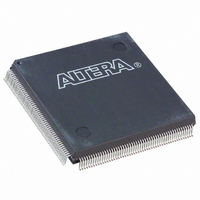EPF10K10AQI208-3 Altera, EPF10K10AQI208-3 Datasheet - Page 15

EPF10K10AQI208-3
Manufacturer Part Number
EPF10K10AQI208-3
Description
IC FLEX 10KA FPGA 10K 208-PQFP
Manufacturer
Altera
Series
FLEX-10K®r
Datasheet
1.EPF10K10ATC100-3.pdf
(128 pages)
Specifications of EPF10K10AQI208-3
Number Of Logic Elements/cells
576
Number Of Labs/clbs
72
Total Ram Bits
6144
Number Of I /o
134
Number Of Gates
31000
Voltage - Supply
3 V ~ 3.6 V
Mounting Type
Surface Mount
Operating Temperature
-40°C ~ 100°C
Package / Case
208-MQFP, 208-PQFP
Lead Free Status / RoHS Status
Contains lead / RoHS non-compliant
Available stocks
Company
Part Number
Manufacturer
Quantity
Price
Company:
Part Number:
EPF10K10AQI208-3
Manufacturer:
ALTERA
Quantity:
57
FLEX 10K Embedded Programmable Logic Device Family Data Sheet
The programmable flipflop in the LE can be configured for D, T, JK, or SR
operation. The clock, clear, and preset control signals on the flipflop can
be driven by global signals, general-purpose I/O pins, or any internal
logic. For combinatorial functions, the flipflop is bypassed and the output
of the LUT drives the output of the LE.
The LE has two outputs that drive the interconnect; one drives the local
interconnect and the other drives either the row or column FastTrack
Interconnect. The two outputs can be controlled independently. For
example, the LUT can drive one output while the register drives the other
output. This feature, called register packing, can improve LE utilization
because the register and the LUT can be used for unrelated functions.
The FLEX 10K architecture provides two types of dedicated high-speed
data paths that connect adjacent LEs without using local interconnect
paths: carry chains and cascade chains. The carry chain supports high-
speed counters and adders; the cascade chain implements wide-input
functions with minimum delay. Carry and cascade chains connect all LEs
in an LAB and all LABs in the same row. Intensive use of carry and
cascade chains can reduce routing flexibility. Therefore, the use of these
chains should be limited to speed-critical portions of a design.
Carry Chain
The carry chain provides a very fast (as low as 0.2 ns) carry-forward
function between LEs. The carry-in signal from a lower-order bit drives
forward into the higher-order bit via the carry chain, and feeds into both
the LUT and the next portion of the carry chain. This feature allows the
FLEX 10K architecture to implement high-speed counters, adders, and
comparators of arbitrary width efficiently. Carry chain logic can be
created automatically by the Compiler during design processing, or
manually by the designer during design entry. Parameterized functions
such as LPM and DesignWare functions automatically take advantage of
carry chains.
Carry chains longer than eight LEs are automatically implemented by
linking LABs together. For enhanced fitting, a long carry chain skips
alternate LABs in a row. A carry chain longer than one LAB skips either
from even-numbered LAB to even-numbered LAB, or from odd-
numbered LAB to odd-numbered LAB. For example, the last LE of the
first LAB in a row carries to the first LE of the third LAB in the row. The
carry chain does not cross the EAB at the middle of the row. For instance,
in the EPF10K50 device, the carry chain stops at the eighteenth LAB and a
new one begins at the nineteenth LAB.
Altera Corporation
15














